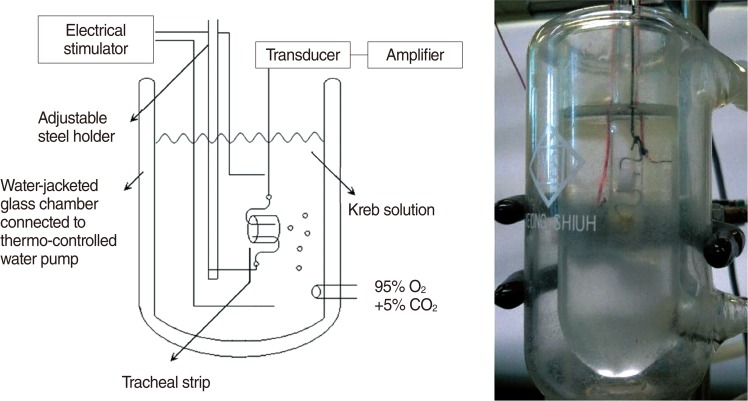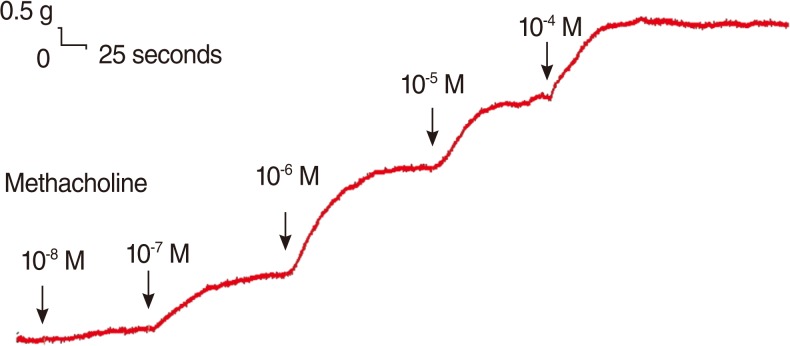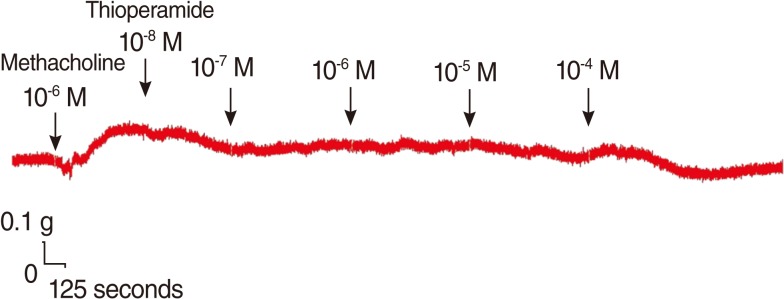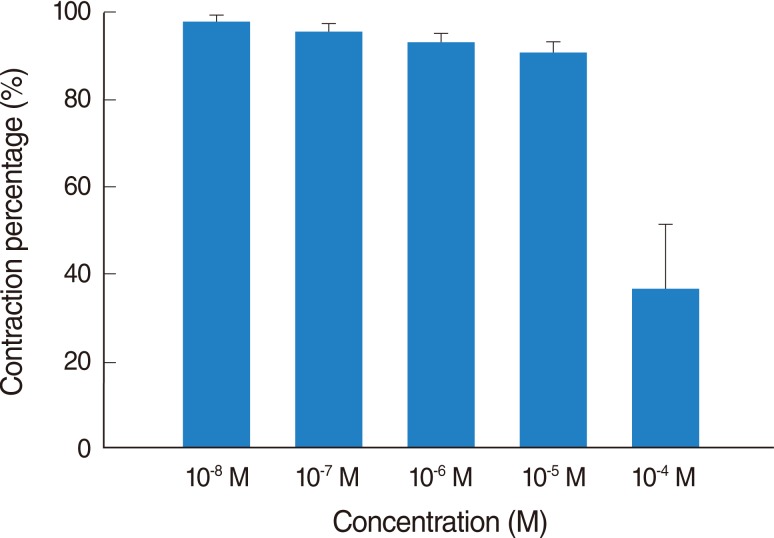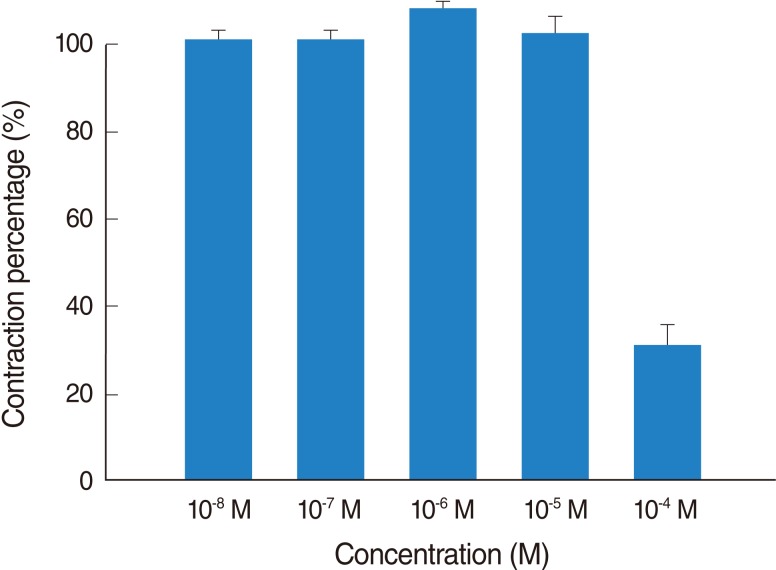Clin Exp Otorhinolaryngol.
2013 Mar;6(1):12-17.
Evaluation of Thioperamide Effects Using Rat's Trachea Model
- Affiliations
-
- 1Department of Otolaryngology-Head and Neck Surgery, Tri-Service General Hospital, National Defense Medical Center, Taipei, Taiwan.
- 2Department of Otolaryngology and Graduate Institute of Clinical Medicine, Taipei Medical University-Shuang Ho Hospital, Taipei, Taiwan. w0512n@ms15.hinet.net
Abstract
OBJECTIVES
Thioperamide is used as an antagonist to the histamine H3 receptor. During administration of the drug, the trachea may be affected via nasal or oral inhalation. This study was to determine the effects of thioperamide on the trachea of rats in vitro.
METHODS
We tested the effectiveness of thioperamide on isolated rat trachea submersed in Kreb's solution in a muscle bath. Changes in tracheal contractility in response to the application of parasympathetic mimetic agents were measured. The following assessments of thioperamide were performed: 1) effect on tracheal smooth muscle resting tension; 2) effect on contraction caused by 10(-6) M methacholine as a parasympathetic mimetic; 3) effect of the drug on electrically-induced tracheal smooth muscle contractions.
RESULTS
Thioperamide induced a significant relaxation response at a preparation concentration up to 10(-4) M. The drug also inhibited the electrical field stimulation induced spike contraction. However, thioperamide alone had a minimal effect on the basal tension of the trachea at increasing concentrations.
CONCLUSION
The study indicated that high concentrations of thioperamide might actually antagonize cholinergic receptors and block parasympathetic function of the trachea.
Keyword
MeSH Terms
Figure
Reference
-
1. Arrang JM, Garbarg M, Schwartz JC. Auto-inhibition of brain histamine release mediated by a novel class (H3) of histamine receptor. Nature. 1983; 4. 302(5911):832–837. PMID: 6188956.
Article2. Bertaccini G, Coruzzi G, Poli E. Leurs R, Timmerman H, editors. Functional role of histamine H3 receptors in peripheral tissues. The histamine H3 receptor: a target for new drugs. 1998. Amsterdam: Elsevier;p. 59–111.
Article3. Suzuki S, Takeuchi K, Majima Y. Localization and function of histamine H3 receptor in the nasal mucosa. Clin Exp Allergy. 2008; 9. 38(9):1476–1482. PMID: 18564330.4. Valentine AF, Rizzo CA, Rivelli MA, Hey JA. Pharmacological characterization of histamine H3 receptors in human saphenous vein and guinea pig ileum. Eur J Pharmacol. 1999; 1. 366(1):73–78. PMID: 10064154.
Article5. Bratton DL, Tanaka DT, Grunstein MM. Effects of temperature on cholinergic contractility of rabbit airway muscle. J Appl Physiol. 1987; 11. 63(5):1933–1941. PMID: 3320012.
Article6. Gonzalez O, Santacana GE. Effect of low temperature on tracheal smooth muscle contractile and relaxing responses evoked by electrical field stimulation. P R Health Sci J. 2001; 9. 20(3):237–244. PMID: 11776725.7. Wang HW, Wang YT, Wu CC. A modified in vitro method for studying tracheal smooth muscle response to drugs. J Med Sci. 2007; 27(5):203–206.8. Kao CH, Chu YH, Wang HW. Effects of cetirizine on isolated rat's tracheal smooth muscle. Eur Arch Otorhinolaryngol. 2009; 5. 266(5):753–757. PMID: 18941763.
Article9. Yau KI, Ko FN, Chien CH. Effects of prokinetic agents on contractile responses to electrical field stimulation of isolated guinea pig trachea. J Formos Med Assoc. 1999; 8. 98(8):567–572. PMID: 10502911.10. Yau KI, Hwang TL. The nonadrenergic noncholinergic system can modulate the effect of prokinetic agents on contractile response of isolated guinea-pig trachea segments to electrical field stimulation. J Formos Med Assoc. 2002; 10. 101(10):695–699. PMID: 12517043.11. Schwartz JC, Arrang JM, Garbarg M, Pollard H. Plenary lecture. A third histamine receptor subtype: characterisation, localisation and functions of the H3-receptor. Agents Actions. 1990; 4. 30(1-2):13–23. PMID: 1695431.12. Wang HW, Jackson RT. Do cholinergic neurons directly innervate nasal blood vessels? Rhinology. 1988; 6. 26(2):139–146. PMID: 3175457.13. James AL, Pare PD, Moreno RH, Hogg JC. Quantitative measurement of smooth muscle shortening in isolated pig trachea. J Appl Physiol. 1987; 10. 63(4):1360–1365. PMID: 3693169.
Article14. Bakker RA, Leurs R. Seifert R, Wieland T, editors. Constitutively active histamine receptors. G protein-coupled receptors as drug targets: analysis of activation and constitutive activity. 2005. Weinheim: Wiley-VCH;p. 195–222.
Article15. Ash AS, Schild HO. Receptors mediating some actions of histamine. Br J Pharmacol Chemother. 1966; 8. 27(2):427–439. PMID: 4381779.
Article16. Black JW, Duncan WA, Durant CJ, Ganellin CR, Parsons EM. Definition and antagonism of histamine H2-receptors. Nature. 1972; 4. 236(5347):385–390. PMID: 4401751.17. Arrang JM, Garbarg M, Lancelot JC, Lecomte JM, Pollard H, Robba M, et al. Highly potent and selective ligands for histamine H3-receptors. Nature. 1987; 5. 327(6118):117–123. PMID: 3033516.
Article18. Passani MB, Lin JS, Hancock A, Crochet S, Blandina P. The histamine H3 receptor as a novel therapeutic target for cognitive and sleep disorders. Trends Pharmacol Sci. 2004; 12. 25(12):618–625. PMID: 15530639.
Article19. Witkin JM, Nelson DL. Selective histamine H3 receptor antagonists for treatment of cognitive deficiencies and other disorders of the central nervous system. Pharmacol Ther. 2004; 7. 103(1):1–20. PMID: 15251226.
Article20. Amaral MM, Alvarez CA, Langellotti C, Jancic C, Salamone G, Geffner J, et al. Thioperamide induces CD4 CD25 Foxp3 regulatory T lymphocytes in the lung mucosa of allergic mice through its action on dendritic cells. J Asthma Allergy. 2011; 4:93–102. PMID: 22034573.21. Hansel TT, Barnes PJ, editors. New drugs for asthma, allergy and COPD. 2001. Basel: Karger.
- Full Text Links
- Actions
-
Cited
- CITED
-
- Close
- Share
- Similar articles
-
- Surgery of the Trachea
- Enhancement of Microvascular Leakage in the Nasal Mucosa after Re-exposure to Capsaicin in a Rat Model Challenged/Rechallenged with Capsaicin
- The Role and Localization of Nitric Oxide Synthasein Neurogenic Inflammation of the Rat Airways
- Evaluation of the extent of the stenosis in relation to the suture materials and methods after End-to-End anastomosis of the trachea
- Influence of the Difference in Temperature and Duration of Storage on the Rejection of Cryopreserved Rat Tracheal Homograft

